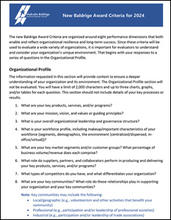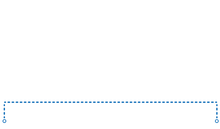Award Criteria
About the Award | How to Apply | Award Cycle Overview | Is Your Organization Eligible | Award Process Fees | Application Format

2024 edition
Download your free copy today.
The new Baldrige Award Criteria are organized around eight performance dimensions that both enable and reflect organizational resilience and long-term success.
Since these criteria will be used to evaluate a wide variety of organizations, it is important for evaluators to understand and consider your organization’s unique environment. That begins with your responses to a series of questions in the Organizational Profile.
Organizational Profile | Performance Dimensions | Criteria Questions for Evaluation | Scoring Rubric

Organizational Profile
The information requested in this section will provide context to ensure a deeper understanding of your organization and its environment.
The Organizational Profile section will not be evaluated.
You will have a limit of 2,000 characters and up to three charts, graphs, and/or tables for each question.
This section should not include details of your key processes or results.

- What are your key products, services, and/or programs?
- What are your mission, vision, and values or guiding principles?
- What is your overall organizational leadership and governance structure?
- What is your workforce profile, including makeup/important characteristics of your workforce (segments, demographics, the environment [centralized/dispersed, in-office/virtual])?
- What are your key market segments and/or customer groups? What percentage of business volume/revenue does each comprise?
- What role do suppliers, partners, and collaborators perform in producing and delivering your key products, services, and/or programs?
- What types of competitors do you have, and what differentiates your organization?
- What are your key communities? What role do these relationships play in supporting your organization and your key communities?
Note: Key communities may include the following:
• Local/geographic (e.g., volunteerism and other activities that benefit your community)
• Professional (e.g., participation and/or leadership of professional societies)
• Industrial (e.g., participation and/or leadership of trade associations) - What are the strategic challenges, threats, advantages, opportunities, core competencies, or other critical factors that most impact your organization’s success and sustainability?
- What are your key applicable regulations, as well as accreditation, certification, or registration requirements?
- Is there anything you consider unusual about your environment or business model that would aid in understanding your organization?
For each of the sections below, there are two types of questions: one asks about key processes used, the other, results and/or outcomes achieved. Both are important in the evaluation process; however, results and outcomes carry more weight and are the focus of the application review phase. For organizations that advance, the site visit review phase will verify performance results and explore key processes, systems, and various role-model characteristics.
Results below will be evaluated based on responsiveness to the question asked, performance levels and trends, comparisons to competitors or industry benchmarks (as appropriate), and relevance of the metrics provided. Relevance can be thought of as whether your organization is measuring what is important to your success and sustainability, to include appropriate segmented data.
Leadership and Governance
- Briefly describe and/or depict your leadership and governance processes and/or systems, including processes for succession planning and for two-way communication.
- What are your results for the effectiveness of senior leaders’ engagement and communication by key workforce segments (e.g., workforce ratings of leaders)?
- What are your results for the effectiveness of senior leaders’ engagement and communication by key customer and stakeholder segments?
- What are your results for leadership and governance accountability (e.g., internal and external audits and assessments, certifications, and accreditations)?
Note: Comparisons are not expected for this question. - What are your results for grievances and complaints, including those related to safety, the Equal Employment Opportunity Commission (EEOC), and ethics?
Strategy
Note: Comparisons not expected for the results in this section.
- Briefly describe and/or depict your key processes used in strategic planning, including development, resource allocation, and execution.
- What are your results for accomplishment of your action plans?
- What are your results for the impact of your organizational strategy?
Note: These are the results demonstrating the impact of accomplishing your strategic goals and/or objectives. - What are your results for achievement of workforce plans, including capability and capacity for strategically important positions?
Operations
- Briefly describe and/or depict your key processes used for the following:
a. design and delivery of your products and services,
b. supply network management, and
c. innovation management. - What are your results for the effectiveness and efficiency of your key processes?
- What are your results for the performance of your key products, services, and/or programs?
- What are the results for the performance of key components of your supply network (e.g., on-time delivery, availability of critical materials, quality)?
- What are your results for cybersecurity effectiveness, including intrusion attempts versus incidents?
Operational Continuity
- Briefly describe and/or depict your key processes used for the following:
a. risk management,
b. continuity of operations, and
c. emergency preparedness. - What are the results for the effectiveness of your risk management plan, including the following:
a. number of risks identified versus number of risks mitigated,
b. cost of losses, and
c. cost savings of risks averted and risks mitigated? - What are the results for the testing of your continuity of operations plan?
- What are the results for the testing of your emergency preparedness plans (e.g., time to evacuate your facility, emergency response time, recovery time)?
Workforce
Note: Results presented below should include data for key workforce segments, where available.
- Briefly describe your key processes used for the following:
a. workforce engagement,
b. workforce development and job skills training, and
c. ensuring workplace health and safety. - What are your results for turnover, retention, and absenteeism?
- What are your results for workforce satisfaction and dissatisfaction?
- What are your results for workforce engagement?
- What are your results for workforce and leadership development, including job skills training?
- What are your results for significant safety-related incidents, including Occupational Safety and Health Administration (OSHA) reportable incidents?
- What are your results for additional indicators of workplace health and safety (e.g., results of safety audits, near-miss tracking)?
Customers and Markets
- Briefly describe your key processes used for the following:
a. customer listening,
b. customer engagement, and
c. customer support. - What are your results for market size and market share, by business unit or product/service, as appropriate?
- What are your results for your customer loyalty, including likelihood to recommend your organization, by key customer segments?
Note: For health care organizations, as appropriate: Include your results for Hospital Consumer Assessment of Healthcare Providers and Systems (HCAHPS) or CAHPS scores. - What are your results for customer complaints, by key customer segments, if available?
- What are your results for customer satisfaction and dissatisfaction, by key customer segments?
Community Engagement
- Briefly describe your key processes for community engagement and societal contributions. Be sure to include your processes for the following:
a. listening and engaging with your key communities, and
b. supporting your key communities. - What are your results for engaging and building relationships with your key communities? Be sure to include results for the following:
a. the number and type of engagements,
b. the frequency of each engagement type (how often the engagement happens), and
c. the length of time of engagements. - What are your results for societal contributions?
Note: See below for some examples of societal contributions:
• reduced energy consumption
• use of renewable energy resources and recycled water
• reduction of your carbon footprint
• waste reduction and utilization
• alternative approaches to conserving resources (e.g., increased virtual meetings)
• global use of enlightened labor practices; and
• donations of goods or services to promote housing, community health, and food security.
Finance
- Briefly describe your key processes used for managing your organization’s finances to ensure the following:
a. financial viability, and
b. access to capital during disruptions. - What are your results for financial viability (e.g., liquidity, days cash on hand/reserves, credit or bond rating)?
- What are your results for financial performance (e.g., revenues, operating margin, performance to budget) by organization units, as appropriate?
Scoring Rubric
Levels & Trends | Comparisons | Relevance | |
|---|---|---|---|
| Low | Results are not responsive to the question or demonstrate adverse performance. | Comparisons to competitors or industry benchmarks are not presented or demonstrate inferior performance. | Results are not presented for areas of importance. |
| Medium | Results responsive to the question are presented and demonstrate satisfactory performance. | Comparisons to competitors or industry benchmarks are presented and demonstrate equivalent performance. | Some results presented are for areas of importance. |
| High | Results responsive to the question are presented and demonstrate favorable performance. | Comparisons to competitors and industry benchmarks are presented and demonstrate superior performance. | Most results presented are for areas of importance. |
Guidance for Process/System Descriptions and Results Requested
In the first question in each section above, briefly describe your processes and/or systems. The description is limited to 2,000 characters and a maximum of three charts/graphs/tables.
For questions 2 and beyond in each section below, where appropriate and possible, use charts, graphs, and/or tables to provide your most recent five years of performance data against relevant comparisons. Include segmentation where requested, and elsewhere as appropriate for your organization. Relevant comparisons may include results for competitors, best-in-class, top decile or quartile, etc. Space will be provided in the online application to explain any missing data or other clarifications as needed.
Related Links
Transformation of the Baldrige Award
2024 Baldrige Award FAQs
Technical Support for Online Application
Baldrige Process Integrity
Baldrige Process Calendar
Baldrige Key Terms
Baldrige Award Recipient Listing
Testimonials
Baldrige Products and Services
Contacts
-
Baldrige Customer Service(301) 975-2036NIST/BPEP
100 Bureau Drive, M/S 1020
Gaithersburg, MD 20899-1020



